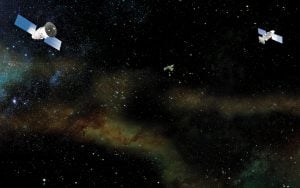
Science & Tech
UN declares International Day of Women in Science
From Roberta Bondar to Harriet Brooks, Canada has more than its fair share of women scientists to be proud of. However women are still a minority in the STEM fields
- 472 words
- 2 minutes
This article is over 5 years old and may contain outdated information.
Science & Tech

Fifty years ago this autumn, after many small steps, Canada took one giant leap into the future.
The successful launch of the Alouette-I satellite on September 29, 1962, made Canada the third nation (after Russia and the United States) to design and build its own satellite and signalled to the world that our country was going to be a player in the space age.
But it wasn’t all smooth sailing straight into the stratosphere for the Ottawabased research and design team, led by the late John Chapman under the auspices of Canada’s Defence Research Telecommunications Establishment (later to become Communications Research Centre Canada). Although the team had world-class engineers and scientists working on the project and believed it would succeed, others weren’t so sure.
“We were certainly confident,” says Colin Franklin, chief electrical engineer of the Alouette-I. “But NASA considered the project too ambitious for the technology at the time. No one believed, outside of ourselves, that it would last.”
The public perception of the task facing the team was not much better. Franklin recalls reading an article published shortly before the Alouette’s launch that stated all the possible things that could go awry during takeoff and highlighted the amount of money being “wasted” on the project. Still, the team was undeterred. “I remember looking at that article,” says Franklin, “and it had absolutely no effect on us.”
Despite their assuredness, launch day at the U.S. Pacific Missile Test Range in California was filled with a degree of uncertainty. Franklin, now 84, remembers the moment the team received word of the satellite’s successful send-off into orbit aboard a Thor-Agena rocket. “There was a huge sigh of relief when it was working, “ he says. “And then there was jubilation.”
From start to finish, the entire Alouette-I project took only 3 ½ years to complete, but it exceeded all expectations. Designed with a nominal lifespan of one year, it spent an impressive 10 active years collecting valuable data about the ionosphere before being decommissioned. Its immediate success kick-started the move to build and launch three more Canadian satellites over the next nine years — Alouette-II, ISIS I and ISIS II — and put Canada in the spotlight.
“The creation, launch and incredible success of the Alouette gave Canada an international reputation for excellence in satellite design and engineering,” says Franklin, adding that at the time, no one on the team realized the long-term significance. “We were not aware that we were doing anything more than successfully building and launching the program. It was just a huge engineering challenge and an exciting program to be on.”
In 1987, Communications Research Centre Canada designated the Alouette-I as one of the 10 most outstanding achievements in the first 100 years of engineering in Canada — a notable tip of the hat that put the satellite in the same company as CPR’s transcontinental railway network, the St. Lawrence Seaway and the CANDU nuclear power system.
For many, the satellite’s launch remains an iconic moment in Canadian history, shot through with personal meaning. Former astronaut Steve MacLean, the current president of the Canadian Space Agency, recalls hearing about it when he was just seven years old. “My dad worked at the National Research Council, so he made sure we remembered stuff like that,” he says. “I collected stamps at the time, and a Canadian stamp with a picture of the Alouette on it came out. It’s kind of a symbolic thing for me.”
MacLean says that it’s hard to predict what the next 50 years have in store for Canada’s space industry but hopes that satellites will, in the next five years, provide communications parity for the country, especially in the North.
For his part, Franklin — who’s faced down naysayers before — doesn’t like to set expectations or limits on what people can accomplish: “People have been spectacularly wrong about forecasting the future before.”
In other words, the sky’s the limit.
Are you passionate about Canadian geography?
You can support Canadian Geographic in 3 ways:

Science & Tech
From Roberta Bondar to Harriet Brooks, Canada has more than its fair share of women scientists to be proud of. However women are still a minority in the STEM fields

Science & Tech
As geotracking technology on our smartphones becomes ever more sophisticated, we’re just beginning to grasps its capabilities (and possible pitfalls)

Environment
Carbon capture is big business, but its challenges fly in the face of the need to lower emissions. Can we square the circle on this technological Wild West?

Science & Tech
Environmental entrepreneur Miranda Wang turns to science to seek profitable solutions to the problem of what to do with our mountains of plastic waste